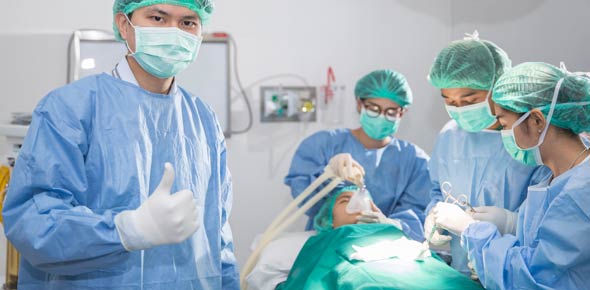While a surgical case is in progress
In which way could a patient's response to impending surgery...
When catheterizing a patient
The most effective protection from the radiation of x-rays is a
When moving the patient from the OR table, who is responsible for...
The room temperature in an operating room (OR) should be
An electrocardiogram is
Tachycardia is a (n)
When flipping a sterile item onto the field, the circulator may
Which action is the responsibility of the scrub person during an...
Which body organ is most susceptible to laser injury?
The body temperature taken orally is 98.6 F. What is it in Celsius?
An item dropped on the floor is considered safe only if
Excessive exposure to radiation can affect the
When using a pour solution
During lateral positioning, a
When using a patient roller, how many people are necessary to move the...
Ionizing radiation protection is afforded by the use of
When opening a wrapper, the circulator should open the top flap
If a patient falls because he or she was left unattended, the OR team...
Which statement is false regarding the position on the OR table?
A patient with a fractured femur is being moved to the OR table. Who...
A potential safety hazard associated with lazer surgery is
A dropped sterile item may only be used if the
Which virus can be transmitted by a needle puncture or splash in the...
When using a high-level disinfectant, always
Liability is a legal rule that
It is considered good technique to
A glass suction bottle should ideally be
A patient was burned on the lip with a hot mouth gag. Which of the...
In the prone position, the thorax must be elevated from the OR table...
A lack of care or skill that any nurse or technician in the same...
If the patient is in a supine position, the circulator must always
Inherited deficiencies of coagulation in which bleeding occurs...
The doctrine of Respondeat Superior refers to
The patient has received preoperative medication. The action to be...
When cleaning the floor between cases
Electrical cords should be
When using an armboard, the most imporant measure is to
The anesthesiologist closes the eyelids of a general anesthetic...
All of the following statements regarding muslin wrappers are true...
Which term indicates low or decreased blood voulme?
Crossing the patient's arms across his or her chest may cause
If an OR staff member wears eyeglasses
The most common artery used to feel the pulse is the
Radiation exposure of the staff is monitored with
A type and crossmatch is done
Diastolic blood pressure refers to
A microscopic blood exam that estimates the percentages of each type...
To avoid compromising the venous circulation, the restraint or safety...
A criteria that idnetifies, measures, monitors, and evaluates patient...
Each of the following applies to an incident report EXCEPT
Why is the obese patient at greater surgical risk than one of normal...
Scatter radiation effects are directly related to
Operative records documenting all aspects of perioperative care are...
To move the patient from the transport stretcher to the OR table
Systolic blood pressure represents
A patient is on antiboagulant drugs. Which of the following tests may...
The lithotomy position requires each of the following EXCEPT
How is inhalation of the laser plume best prevented?
Preoperative chest x-rays
Areas needing special leaning attention on a weekly or monthly...
A patient signs a permission form for surgery, but because of a...
The maximum storage life for a muslin wrapped item in a closed cabinet...
Uncontrolled increased positive pressure in one side of the thorax...
Storage shelves must be cleaned with a germicide
To prevent strain to the lumbosacral muscles and ligaments when the...
Which of the following is the only acceptable plastic that can be used...
Room temperature for infants and children should be maintained as warm...
What is the standard safety margin on package wrappers?
Activated glutaraldehyde is used to disinfect endoscopes for
Ulnar nerve damage could result from
Ethylene oxide destroys cells by
A precaution always taken when the patient is in the supine position...
Which is not considered a safe procedure when caring for dentures...
In which burn classification are the skin and subcutaneous tissue...
When procedure is NOT absolutely necessary in patient identification?
While using this mixture, a scavenging system is used to collect and...
All of the following are requirements of the Kraske position EXCEPT
Extreme positions of the head and arm can cause injury to the
Each statement regarding OR attire is true EXCEPT
Sterile gloves
When moving a patient with a fracture in the OR, all of thefollowing...
Which of the following is not an acceptable wrapper for gas...
An OR hazard that has been linked to increased risk of spontaneous...
External cardiac compression
When drawing a blood sample for arterial blood gases (ABGs) , what is...
The chemical sterilant used in the STERIS method of sterilizing is
The legal doctrine that mandates every professional nurse and...
The best measure for staff protection against HIV is
A patient scheduled for surgery has a hematocrit reading of 40% of...
Except for endotracheal tube installation, basic life support cannot...
Anesthetized patients should be moved slowly to
If the surgeon wants to assess the patient's ability to void...
When the scrub nurse opens an inner sterile wrapper
Packages wrapped in muslin must have
After being scheduled in the OR for a routine tonsillectomy, the nurse...
The preoperative urinalysis test done on a patient indicates that the...
The Endoflush system
What is the function of an aerator in EO sterilization?
















